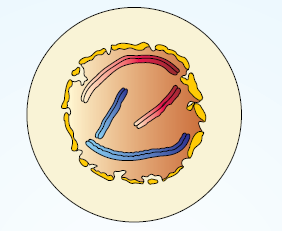The cell shown in the given diagram is in:

1. Early prophase
2. Late prophase
3. Metaphase
4. Telophase

In oocyte of some vertebrates, the stage of meiosis I that can last for months or years would be:
1. Zygotene
2. Pachytene
3. Diplotene
4. Diakinesis
At what phase of meiosis are homologous chromosomes separated ?
1. Prophase l
2. Prophase ll
3. Anaphase l
4. Anaphase ll
The following cell, undergoing mitosis, is at:
1. Early prophase
2. Late prophase
3. Transition to metaphase
4. Early metaphase
Anaphase promoting complex (APC) is a protein degradation machinery necessary for proper mitosis of animal cells. If APC is defective in a human cell, which of the following is expected to occur?
(1) Chromosomes will not condense
(2) Chromosomes will be fragmented
(3) Chomosomes will not segregate
(4) Recombinantion of chromosome arms will occur
DNA replication in bacteria occurs
(1) during S-phase
(2) within nucleolus
(3) prior to fission
(4) just before transcription
Which of the following options gives the correct sequences of events during mitosis?
(1) Condensation → nuclear membrane disassembly → crossing over → Segregation → telophase
(2) Condensation → nuclear membrane disassembly → arrangement at equator → centromere division → Segregation → telophase
(3) Condensation → crossing over → nuclear membrane disassembly → Segregation → telophase
(4) Condensation → arrangement at equator → centromere division → Segregation → telophase
During cell growth, DNA synthesis takes place in
(1) S-phase
(2) -phase
(3) -phase
(4) M-phase
When cell has stalled DNA replication fork, which checkpoint should be predominantly activated?
(1) G1/s
(2) G2/M
(3) M
(4) Both G2/M and M
A cell at telophase stage is observed by a student in a plant brought from the field. He tells his teacher that his cell is not like other cells at telophase stage. There is no formation of cell plate and thus the cell is containing more number of chromosomes as compared to other dividing cells. This would result in
(1) polyploidy
(2) somaclonal variation
(3) polyteny
(4) aneuploidy





